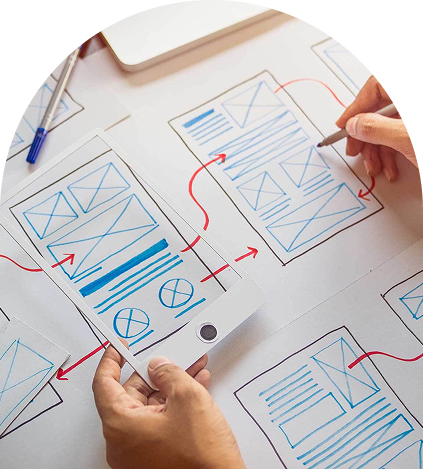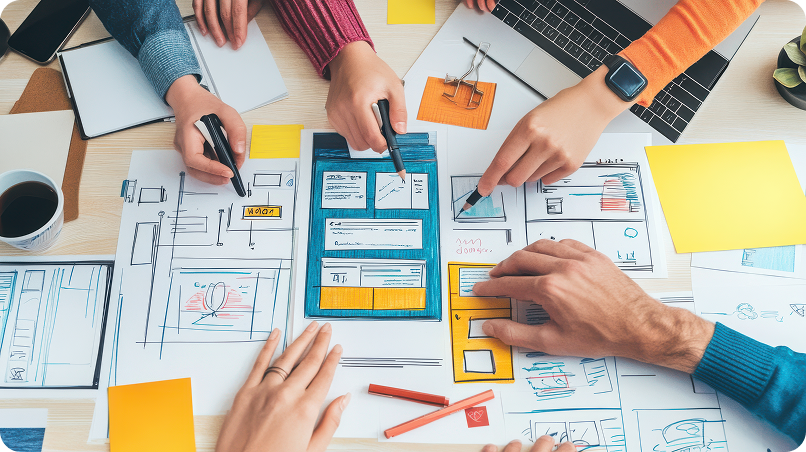
Wireframing and Prototyping Secrets Every UX Designer Needs
Wireframing and prototyping are where your ideas come to life. It's like sketching a map before you start your journey. These tools allow designers to quickly test and change their concepts, making sure everything works smoothly. It's all about making every click and interaction feel just right.
With wireframing and prototyping tools, the possibilities are endless. You can try out new ideas in real-time, seeing how users interact with your designs. It takes the guesswork out of the process, helping you create something that resonates and sticks with your audience. It's where the magic happens!

A Complete Guide to the UX Design Process
The UX design process is your plan for creating products that genuinely prioritize the user. It walks you through each step, from understanding your users’ needs to testing your design. By staying focused and organized, you’ll craft products that not only meet expectations but leave a lasting, positive impression on users. Trust the process and watch your designs shine!
- Collect insights through user research using surveys, interviews, and analytics to understand user needs.
- Develop basic layouts with wireframing to visualize structure and flow before detailed design.
- Build interactive models through prototyping to test functionality and gather early feedback.
- Conduct usability tests as part of the UX design process to identify issues and validate design decisions.
- Refine and improve designs through iteration based on testing results and stakeholder feedback.
Comparing Low Fidelity and High Fidelity UX Prototypes
Low fidelity and high fidelity prototypes are like different tools for different tasks. Low fidelity is quick and simple, great for early brainstorming, while high fidelity is detailed and polished, perfect for testing real user interactions. Knowing when to use each helps you move smoothly through the design process.

Designers often rely on proven methods to visualize ideas efficiently, as explained in this detailed guide to wireframing and prototyping for UX professionals.
The Importance of User Research in UX Design
User research is the key to great UX design. It helps designers really understand how users think, what they need, and where they get frustrated. This insight lets designers create interfaces that not only look great but solve real problems, leading to better user satisfaction and more engagement when wireframing and prototyping.
Throughout the design process, user research guides decision-making. Whether it's through surveys, interviews, or usability tests, this research ensures the design solutions are practical, efficient, and aligned with both business goals and user expectations. It's about crafting experiences that work for everyone, making sure no one is left behind.
User research also helps uncover hidden issues and needs that might otherwise be overlooked. By digging deeper into user behavior, designers can make smarter, more informed decisions. This results in experiences that truly connect with users and create products they’ll love to use, ultimately leading to stronger, lasting connections.

Essential UX Tools Every Designer Needs To Know
UX tools are a game-changer for designers, helping turn creative ideas into user-friendly digital experiences. These tools simplify workflows, boost teamwork, and make the process of crafting prototypes much smoother. Without them, design work would feel slower, disconnected, and less impactful, making it harder to bring ideas to life.
Designers have many options when it comes to wireframing and prototyping. UX tools like Figma, Adobe XD, and Sketch allow designers to work quickly, get immediate feedback, and collaborate seamlessly with developers. This boosts productivity, helps maintain design quality, and ensures everyone is on the same page throughout the process.
UX tools continue to evolve, offering new features like motion effects, live usability tests, and collaborative design spaces. The more designers learn to use these tools, the more powerful their designs become. The better you understand them, the more engaging and memorable the user experience you create will be.
Best design collaboration Techniques For UX Teams Success
Design collaboration is important for UX teams to grow. It ensures everyone stays on the same page, communicates effectively, and works towards shared goals. By collaborating well, teams boost creativity, streamline workflows, and ultimately create solutions that not only meet but exceed expectations. Strong teamwork is the foundation of successful design!
- Encourage open discussions during regular team meetings to keep everyone aligned and connected throughout the wireframing and prototyping process.
- Work together in shared digital spaces like Figma, Miro, or Notion to brainstorm ideas and make real-time updates seamlessly.
- Bring designers, developers, and stakeholders together for open problem-solving sessions that spark creativity and fresh perspectives.
- Schedule regular feedback rounds to review designs, share insights, and continuously improve collaboration and outcomes.
- Keep every version organized and consistent by tracking design changes carefully, maintaining clarity and efficiency in design collaboration.

Latest UX design trends You Should Follow Today
UX design trends are constantly changing, and keeping up with them is essential for creating fresh, engaging interfaces. Simplicity, personalization, and immersive experiences are more important than ever. Staying updated on these trends ensures your designs remain modern, accessible, and relevant, helping you stand out in a busy digital market and capture users' attention.
UX design trends like dark mode, micro-interactions, and voice interfaces are setting new expectations for user experiences. Incorporating these trends into your designs enhances usability and makes products more visually appealing. When used strategically, these features not only improve the user experience but also create a memorable digital product that users will want to engage with again and again.
UX design trends inspire new thinking and encourage designers to try out fresh patterns and tools. This creative freedom leads to standout experiences that not only connect with users but also strengthen your brand identity. When done right, these trends help your product shine in a crowded digital market, leaving a lasting impression.
Conducting thorough UX Trends is essential to understand user needs, preferences, and pain points, ensuring your designs are intuitive and effective.
Conclusion
Wireframing and prototyping are what set great designers apart. They transform complex ideas into easy-to-use solutions. With the right tools, design thinking, and teamwork, you can create digital products that aren't just functional but also engaging and efficient, making the user experience unforgettable.
Gathering user feedback during prototype development ensures you're on the right track. Regular testing and quick tweaks refine the design, making it smoother and more enjoyable. This process not only enhances the experience but also encourages users to keep coming back and share it with others.
Do you want to create the best user experiences? Contact us and let us create amazing user experiences. With our mobile UI UX design services, we can turn the ideas on your digital apps into user-friendly experiences.
Start Your Expert Consultation
Please write your name and contact information below. We will respond as soon as possible.






